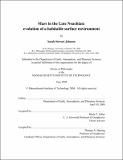Mars in the late Noachian : evolution of a habitable surface environment
Author(s)
Johnson, Sarah Stewart
DownloadFull printable version (11.55Mb)
Other Contributors
Massachusetts Institute of Technology. Dept. of Earth, Atmospheric, and Planetary Sciences.
Advisor
Maria T. Zuber.
Terms of use
Metadata
Show full item recordAbstract
This dissertation addresses whether simple life forms might have existed on Mars during the late Noachian epoch, and whether those life forms, or their traces, can be detected today. It begins by analyzing the ancient Martian climate in light of new evidence that sulfur chemistry played a prominent role in the planet's early evolution. It finds that sulfur-induced greenhouse warming could have periodically heated the planet enough to support liquid water, thereby creating warm, wet, clement conditions. Moreover, it finds that those warming pulses, while short-lived over geologic time, may have persisted for hundreds of years. If sulfur helped create environmental conditions capable of hosting life, however, it also created conditions that were adverse to sustaining it. In particular, dissipation of sulfur volatiles cooled the climate, and sulfur rainout contributed to the acidity of Martian surface waters. The dissertation therefore proceeds to analyze the potential for persistence and detection of life in terrestrial environments with Mars-like characteristics. It first investigates the potential for detecting ancient life by searching for lipid biomarkers in sulfur-rich acid salt lakes, concluding that a variety of biomarkers may be more resistant to decay than previously believed. It then analyzes soil samples from permafrost, discovering the oldest independently authenticated viable organisms ever found, and positing low-level metabolic activity and DNA repair as a survival mechanism in ancient cells. Finally, the dissertation uses deep sequencing to examine prokaryotic diversity in a terrestrial Mars-like river characterized by low pH and high concentrations of iron and sulfur, with results considered in light of the implications for life detection approaches incorporating new, in situ "PCR in a chip" technology. The dissertation concludes by proposing future work, including the ultimate goal of developing a life detection instrument for Mars.
Description
Thesis (Ph. D.)--Massachusetts Institute of Technology, Dept. of Earth, Atmospheric, and Planetary Sciences, 2008. This electronic version was submitted by the student author. The certified thesis is available in the Institute Archives and Special Collections. Includes bibliographical references.
Date issued
2008Department
Massachusetts Institute of Technology. Department of Earth, Atmospheric, and Planetary SciencesPublisher
Massachusetts Institute of Technology
Keywords
Earth, Atmospheric, and Planetary Sciences.